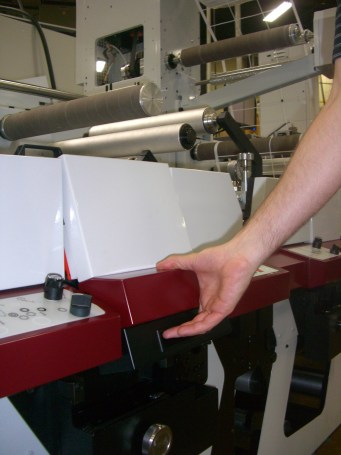
Simplicity…Speed…Ergonomics—when every second counts, bottlenecks must be removed; productivity must be enhanced; accuracy and consistency must be guaranteed; converting capacity cannot be curtailed.
Engineers at Mark Andy, Inc. embraced these critical premises in developing Quick Change Die Cut (QCDC) technology. Introduced in September 2012, the design of the new die cut station promotes faster changeovers and enhances matrix stripping speeds. Early field reports attest to:
- Orchestration of some die changes in as fast as 30 seconds
- Speed increases of up to 50 percent on the most difficult jobs
- Longer die life
- Limited die damage in the loading/unloading process
- Faster set up times that support the opportunity to take on
- more jobs and generate significant increases in incremental revenue
Based on converters’ initial experiences with QCDC, Flexographic Technical Association named it the winner of its prestigious 2013 Technical Innovation Award.
Supporting documentation, included with Mark Andy’s winning entry, stressed QCDC’s ability to unlock capacity and profitability on the Performance Series press. “Faster changeovers, faster running speeds, and fewer matrix breaks can lead to 45 percent capacity creation,” states John Howard, product manager, Mark Andy. “Based on production data, a typical two-shift flexo printing/converting operation that runs 3,720 straight forward jobs per year can grow that number to 4,724 with incorporation of a QCDC station.”
With 1,494 more jobs per year, total revenue gain, based on today’s dollars for one press running two shifts, over five years, would total $5.9 million in incremental revenue. Howard adds, “In 10 years’ time, that figure leaps to $11.7 million.”
Created with Purpose
QCDC die cutting technology was created for the Mark Andy Performance Series flexo printing platform (winner of FTA’s Technical Innovation Award in 2011—see FLEXO Magazine June 2011, page 28 and October 2011, cover and page 50). Any new model P5 or P7 press, as well as the 200+ existing installations, can be configured or retrofitted with single or dual-station QCDC die cut capability.

According to Howard, “Traditional die cut designs are vertical. We found that components, if not properly aligned, could produce inconsistent cuts based on surface contact. QCDC was designed with stiffer components and refined, in-line cylinder alignment, providing more consistent cuts without liner strikes and better die line squareness to fit the printed image.”
Height from floor to top of die station is 38-in. Howard asserts that this horizontal, in-line roll geometry holds rolls (die, support, anvil) more securely, eliminating deflection and inconsistencies and allows an operator to manage a die changeover without bending, lifting, reaching or straining. Furthermore, he maintains, “The top guard design allows complete access to the entire die station during setups, something press operators really appreciate.”
Elaborating on those points, Howard notes that the horizontal layout of die station components gives more stability and consistency to die pressure. Rolls are able to run cooler, with little to no expansion or contraction. Thinner material liners are cut more consistently, causing little to no liner strikes; all of these resulting in more accurate die lines and reduced waste.
Key Attributes
QCDC technology is described by Mark Andy as a completely new approach to die cutting. Key attributes include pushbutton hydraulic tractor actuation, cassette and cart system designed to load in less than one minute and capstan tension regulation allowing high-speed matrix removal.

Howard explains, “At the push of a button, tractors are hydraulically moved away from the die for die removal or are hydraulically moved to load the die for cutting, eliminating the need to remove tractors for changeover. Hydraulic actuation provides precise pressure, displayed on gauges, which is programmable, and can be saved and recalled for repeat jobs.”
“QCDC’s cassette system loads in less than one minute,” he continues. “Dies are loaded into simple cassettes offline while the press is running production. As the press is stopped for a die change, the finished die is pulled out onto the specially designed die cart and the new die is loaded. Tractors retract and load the die cylinder hydraulically at the push of a button.”
Changeover times have been cut by 80 percent, thanks to QCDC technology. A process that used to take 7:30 minutes, now requires just 1:20 minutes on average.
Of note, the QCDC cassette and cart allow operators to load and unload dies without the use of a hoist, eliminating heavy lifting and delivering ergonomic benefits for the operator. Also of importance, if the press is equipped with a dual-station QCDC unit, one station can be completely set up while the press is running a job using a second station.
Precise tension regulation, manipulatable to very low tensions, can be recorded and recalled for future runs, pulling even the most delicate matrix jobs at high speeds, a point that had previously caused a bottleneck in the inline converting process. In fact, high-speed matrix stripping has matched maximum Performance Series press speeds.
An additional benefit is the simple transition from top- to under-side die cutting. “It involves only a simple re-web of the press, not complete die removal,” comments Howard. The result is faster job changeovers—something always attractive to flexographers interested in maintaining the best possible competitive posture.
They stand intrigued by a pledge of better accuracy at higher press speeds and intent on producing larger quantities of high quality, saleable product from the press in the same—or less—time.

QCDC Performance Profile
- Created for Mark Andy Performance Series press platforms
- Features stiff components and refined, in-line cylinder alignment
- Cuts changeover times by 80 percent
- Removes stripping speed limits
- Dramatically reduces die damage
- Delivers consistent cuts without liner strikes and better die line squareness to fit the printed image
- Maximizes press speed
- Minimizes waste generated